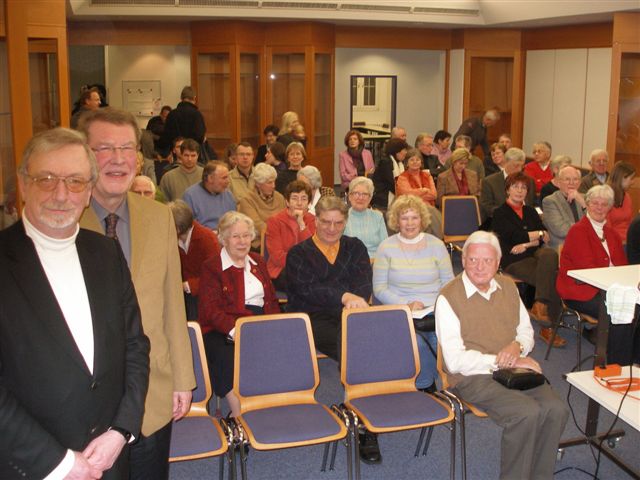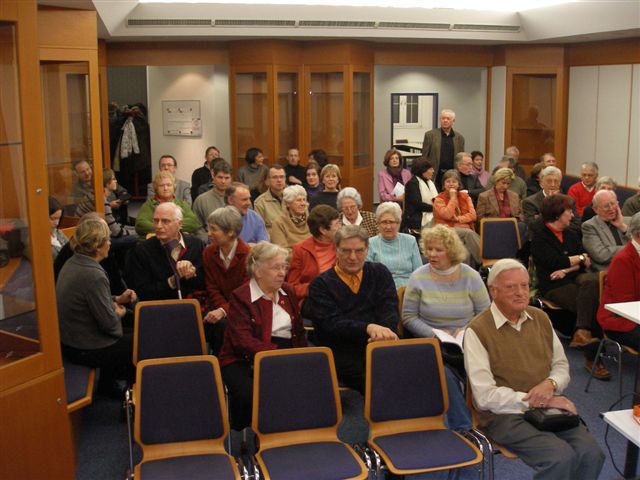Peter Freese:
Der amerikanische Süden – The American South
Begleitmaterial zum Vortrag
Das Mitglied des DAFK, Professor em. Dr.Dr. h.c. Peter Freese, Universität Paderborn, hielt am 29.1.2009 in den Räumen der VHS vor etwa 60 Zuhörern und Zuhörerinnen einen aufschlussreichen Vortrag über den „Amerikanischen Süden“.
| Professor Freese, daneben, DAFK-Präsident Bernd Broer. |
Angeregte Unterhaltung vor dem Vortrag. Fotos: O. Allendorf |
The American South
Prof. em. Dr. Dr. h. c. Peter Freese
University of Paderborn
February 2009
1: Defining ‘the South’
Introductory attempts at a geographical definition lead to various answers such as
· the eleven states of the Confederacy
· these states plus the ‘border states’ of Kentucky, Maryland and Missouri
· the ‘modern’ definition which also includes Delaware, West Virginia, Oklahoma, and the District of Columbia
· the definition used by the U.S. Census (16 states plus Washington, D.C.)
Considerations of the climate and the culture show that there are many climatic and cultural differences within what is loosely called ‘the South’:
[…] the almost tropical Deep South (low country, Gulf Coast) is not quite the same South as the smoky blue hills of Appalachia; tidewater Virginia is not the industrial piedmont; Savannah and Charleston resemble each other more than metropolitan Atlanta; and the Mississippi Delta, pine barrens, and rugged hills have not historically melded into a unit that locates Barry Hannah comfortably across the same literary backyard as Walker Percy. (Doris Betts, “Introduction” to Tonette Bond Inge, ed. Southern Women Writers: The New Generation , pp. 2f.)
‘The South,’ then, is less a precisely definable geographical area than a cultural region of the mind whose contours and characteristics have frequently shifted throughout the course of history.
The commodified image of ‘the South’ as propagated by the media and the tourism industry is somehow
· situated between the French Quarter in New Orleans and Fort Sumter in Charleston Harbor, between Elvis Presley’s Graceland in Memphis and the Grand Ole Opryin Nashville, Tennessee;
· contrastively evoked by D. W. Griffith’s enormously influential film Birth of a Nation(1915) glorifying the Ku Klux Klan and Harriet Beecher Stowe’s abolitionist novel Uncle Tom’s Cabin (1852) deploring the crime of slavery; or between Margaret Mitchell’s successfully filmed and frequently continued mega-bestseller Gone with the Wind (1936; film 1939) and Alex Haley’s genealogical novel Roots: The Saga of an American Family(1976) and its popular TV version (1977);
· characterized by such commodities as catfish and collards, watermelons and mint juleps, hush puppies and chitterlings and by such famous brands as Colonel Sanders’ Kentucky Fried Chicken, Uncle Ben’s Rice, Aunt Jemima Pancake Flour, Southern Comfort, and sundry kinds of famous Kentucky Bourbons;
· endlessly sung and yodeled about in gospels and blues, hillbilly music, bluegrass rhythms, and rock’n roll; and
· represented by such diametrically opposite figures as Thomas Jefferson, the drafter of the Declaration of Independence, and John C. Calhoun, the sectionalist champion of state rights and the doctrine of nullification.
Among the major – and contradictory – myths of the South are
· the (positive) myth of the Old South – <Moonshine and Magnolia> – <The Lost Cause of the Confederacy>
· the (negative) myth of <the Benighted South> (see H. L. Mencken’s famous essay “The Sahara of the Bozart” [= beaux art] of 1917)
· the recent myth of <the New South> or <Sunbelt> (in 1969 Kevin Phillips coined the term; in 1976 Kirkpatrick Sale identified a “Southern Rim” of states that were gaining more political power with each postwar census; today the “Sunbelt” is taken to refer to the states or parts of states that lie south of the 37th degree latitude)
With all – conflicting – definitions, however, one has to keep in mind the famous exchange between Quentin Compson and his puzzled Canadian roommate at Harvard in William Faulkner’s Absalom, Absalom!
“We don’t live among defeated grandfathers and freed slaves […] and bullets in the dining room table and such, to be always reminding us to never forget. What is it? something you live and breathe in like air? a kind of vacuum filled with wraithlike and indomitable anger and pride and glory at and in happenings that occurred and ceased fifty years ago? a kind of entailed birthright of father and son and father and son of never forgiving General Sherman, so that forever more as long as your children’s children produce children you won’t be anything but a descendent of a long line of colonels killed in Pickett’s charge at Manassas?”
“Gettysburg. You can’t understand it. You would have to be born there.”
(William Faulkner, Absalom, Absalom! The Corrected Text , p. 289)
2: The Old South
Brief visits to
· Jamestown (the foundation myth of Captain John Smith and Pocahontas)
· Charleston (first theater in the US, Beth Elohim Synagogue, bombardment of Fort Sumter)
· Shirley Plantation (founded in 1613; oldest family-owned business – tobacco – seehttp://www.shirleyplantation.com/timeline.html
for a Shirley timeline, and
http://www.historypoint.org/education/teaching
/history_backyard/tobacco_slavery_virginia_colonies.asp
for information about “Tobacco and Slavery in the Virginia Colony”
· Middleton Place (founded in 1741 – rice – seehttp://www.middletonplace.org/default.
asp?name=site&catID=4524&parentID=4510)
· Boon Hall (founded in 1743 – slave quarters)
· indigo as a third important (labor-intensive) crop besides tobacco and rice and, later, cotton
(as to literature of the Old South see, e.g., Ben Forkner and Patrick Samway, S.J., eds. Stories of the Old South. New York: Viking Penguin, 1986)
3: The Deep South
· Jackson, Mississippi
· the Civil Rights Movement – Jim Crow Laws – Plessy v Ferguson – Brown v Board of Education of Topeka – racism still extant: see the quarrel about a “white only” tree in the yard of the high school in Jena, Louisiana, which, in 2007!, led to nationwide controversies and public outrage (see, e.g., http://www.npr.org/templates/player/mediaPlayer.html?action
=1&t=1&islist=false&id=12353776&m=12357717)
· a suitable film: Alan Parker’s Mississippi Burning (1988)
· Frank Yerby’s short story “The Homecoming” (1946)*
· Joan Williams’ short story “Spring Is Now” (1968)*
· Kudzu (pueraria lobata)
· Oxford, Mississippi – “Ole Miss” – Rowan Oak – William Faulkner’s Yoknapatawpha County (see, e.g., “Faulkner on the Net“ (http://cypress.mcsr.olemiss.edu/~egjbp/faulkner/faulkner.html,
a veritable treasure trove of information)
· William Faulkner’s short story “A Rose for Emily” (1930)*
· Poverty – a central document: Let Us Now Praise Famous Men (1941) with texts by James Agee and photographs by Walker Evans
· Harper Lee, To Kill a Mockingbird (1960) – Monroeville, Alabama
· The “lynching bee” – Billie Holiday’s song “Strange Fruit” – Lilian Smith’s novel Strange Fruit (1941) – James Baldwin’s story “Going to Meet the Man” (1965) – Erskine Caldwell’s story “Saturday Afternoon” (1936)*
· The Bible Belt – religious fundamentalism – Southern Baptists – Flannery O’Connor’s story “A Good Man Is Hard to Find” (1953)*
4: The Cajun South
· New Orleans – the French Quarter – the Garden District – Tennessee Williams’ A Streetcar Named Desire (1947; Elia Kazan’s film 1951) – Anne Rice, Interview with the Vampire (1976) – Truman Capote, Other Voices, Other Rooms (1948) – St. Louis No. 1 – Marie Laveau
· The Bayous – The Great Expulsion (1755) of the Acadians > Cajuns –– food – music – Kate Chopin’s short story “Désirée’s Baby” (1893)* – her novel The Awakening (1899)
· Oak Alley
· Houmas House
· Nottoway/White Castle
· Oakley Plantation – John James Audubon, Birds of America


